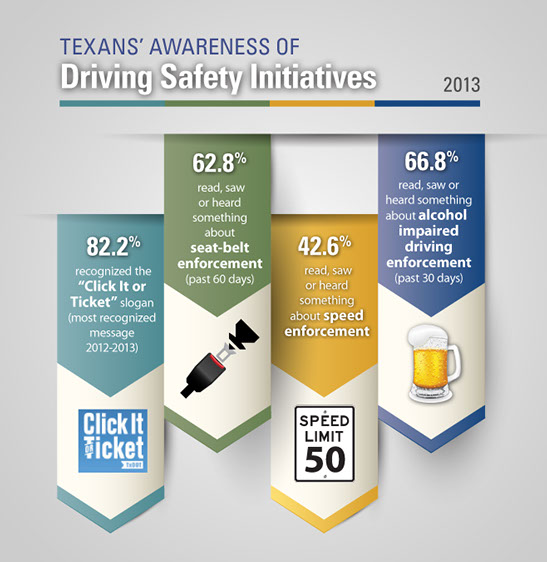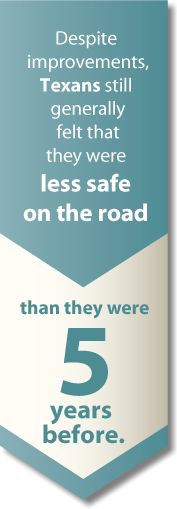
Survey also tracks awareness of safety programs, campaigns

 Survey Results
Survey Results
The first set of questions measured how driver awareness had changed from previous surveys by asking drivers questions about their awareness on several traffic safety issues. An increased number of drivers this year — 27.4 percent — said they never go faster than 75 mph when the speed limit is 70 mph, up from 21.8 percent in 2012. Another improvement was seen in the percentage of Texans who said they sometimes or regularly talk on a cell phone while driving – 41.6 percent in 2013, compared to 46.6 percent in 2012. However, the percentage who said they sometimes or regularly text while driving remained the same.
A discouraging statistic showed that 88.1 percent of 2013 respondents said the chances of getting a ticket for exceeding the speed limit by more than 5 mph was likely to very likely, a reduction from 93.1 percent in 2012.
The second set of questions focused on respondents’ awareness of driving safety initiatives.
• 82.2 percent of 2013 respondents recognized the “Click It or Ticket” slogan. In both 2012 and 2013, “Click it or Ticket” was the most recognized message among respondents.
• 62.8 percent of respondents in 2013 said they had read, seen or heard something about seat belt enforcement by police in the past 60 days, a decrease from 70.2 percent in 2012.
• The percentage of respondents who reported they had read, seen or heard something about speed enforcement by police decreased in 2013 from 49.7 to 42.6 percent.
• 66.8 percent of 2013 respondents said they had read, seen or heard something about alcohol impaired driving enforcement within the past 30 days, a decrease from 74.1 percent in 2012.
 Another survey looked into the opinions of Texans about driving safety laws and conditions. According to the 2013 Traffic Safety Culture survey sponsored by the Center for Transportation Safety at TTI, results showed that a healthy portion of Texans favored strengthening laws to advance traffic safety. The same survey was conducted in 2010.
Another survey looked into the opinions of Texans about driving safety laws and conditions. According to the 2013 Traffic Safety Culture survey sponsored by the Center for Transportation Safety at TTI, results showed that a healthy portion of Texans favored strengthening laws to advance traffic safety. The same survey was conducted in 2010.
• A mandatory motorcycle helmet law gained support in recent years, and currently, more than 76 percent either favor or strongly favor a universal law.
• 34.4 percent of respondents in 2013 said they were in favor of legislation being passed against the use of cell phones while driving, an increase from 30.3 percent in 2010. More than 80 percent of respondents in both the 2010 and 2013 surveys believe that cell phone use behind the wheel has become a bigger problem than it was five years ago.
• 61.5 percent of the 2013 survey respondents said seat belt use was better that year than five years prior, an increase from 49 percent who said the same thing in 2010.
• 81.5 percent of 2013 respondents said texting while driving was worse than five years ago, a decrease from 85.1 percent in 2010.
Despite improvements in some respects, Texans still generally felt that they were less safe on the road than they were five years before. That sentiment was shared by 40.8 percent of respondents in 2013, up from about 35 percent who said the same in 2010.
The surveys also measured changes in driver awareness in regions throughout the state. The best improvement on a regional level, for seat belt use, was in El Paso. In 2012, respondents from the El Paso area were the least likely in the state (32.7 percent) to believe that a person would get a ticket for not wearing a seat belt. In 2013, the number who expected to be cited for a seat belt violation jumped to 59.9 percent. Also, 72.3 percent of El Paso respondents – the highest in the state – reported they had heard a seat belt enforcement message in the past 60 days in 2013.